2.3E: Limit Laws and Techniques for Computing Limits EXERCISES
- Last updated
- Jan 17, 2020
- Save as PDF
- Page ID
- 32762
( \newcommand{\kernel}{\mathrm{null}\,}\)
2.3: The Limit Laws
In the following exercises, use the limit laws to evaluate each limit. Justify each step by indicating the appropriate limit law(s).
83) limx→0(4x2−2x+3)
- Answer:
-
Use constant multiple law and difference law:
limx→0(4x2−2x+3)=4limx→0x2−2limx→0x+limx→03=3
84) limx→1x3+3x2+54−7x
85) limx→−2√x2−6x+3
- Answer:
-
Use root law: limx→−2√x2−6x+3=√limx→−2(x2−6x+3)=√19
86) limx→−1(9x+1)2
In the following exercises, use direct substitution to evaluate each limit.
87) limx→7x2
- Answer:
- 49
88) limx→−2(4x2−1)
89) limx→011+sinx
- Answer:
- 1
90) limx→2e2x−x2
91) limx→12−7xx+6
- Answer:
- −57
92) limx→3lne3x
In the following exercises, use direct substitution to show that each limit leads to the indeterminate form 0/0. Then, evaluate the limit.
93) limx→4x2−16x−4
- Answer:
- limx→4x2−16x−4=16−164−4=00;then,limx→4x2−16x−4=limx→4(x+4)(x−4)x−4=8
94) limx→2x−2x2−2x
95) limx→63x−182x−12
- Answer:
- limx→63x−182x−12=18−1812−12=00
then, limx→63x−182x−12=limx→63(x−6)2(x−6)=32
96) limh→0(1+h)2−1h
97) limt→9t−9√t−3
- Answer:
- limx→9t−9√t−3=9−93−3=00;then,limt→9t−9√t−3=limt→9t−9√t−3√t+3√t+3=limt→9(√t+3)=6
98) limh→01a+h−1ah, where a is a real-valued constant
99) limθ→πsinθtanθ
- Answer:
- \displaystyle \lim_{θ→π}\frac{\sin θ}{\tan θ}=\frac{\sin π}{\tan π}=\frac{0}{0}; then, \displaystyle \lim_{θ→π}\frac{\sin θ}{\tan θ}=\displaystyle \lim_{θ→ π}\frac{\sin θ}{\frac{\sin θ}{\cos θ}}=\displaystyle \lim_{θ→π}\cos θ=−1
100) \displaystyle \lim_{x→1}\frac{x^3−1}{x^2−1}
101) \displaystyle \lim_{x→1/2}\frac{2x^2+3x−2}{2x−1}
- Answer:
- \displaystyle \lim_{x→1/2}\frac{2x^2+3x−2}{2x−1}=\frac{\frac{1}{2}+\frac{3}{2}−2}{1−1}=\frac{0}{0}; then, \displaystyle \lim_{x→ 1/2}\frac{2x^2+3x−2}{2x−1}=\displaystyle \lim_{x→1/2}frac{(2x−1)(x+2)}{2x−1}=\frac{5}{2}
102) \displaystyle \lim_{x→−3}\frac{\sqrt{x+4}−1}{x+3}
In the following exercises, use direct substitution to obtain an undefined expression. Then, use the method of Example to simplify the function to help determine the limit.
103) \displaystyle \lim_{x→−2^−}\frac{2x^2+7x−4}{x^2+x−2}
- Answer:
- −∞
104) \displaystyle \lim _{x→−2^+}\frac{2x^2+7x−4}{x^2+x−2}
105) \displaystyle \lim _{x→1^−}\frac{2x^2+7x−4}{x^2+x−2}
- Answer:
- −∞
106) \displaystyle \lim_{x→1^+}\frac{2x^2+7x−4}{x^2+x−2}
In the following exercises, assume that \displaystyle \lim_{x→6}f(x)=4,\displaystyle \lim_{x→6}g(x)=9, and \displaystyle \lim_{x→6}h(x)=6. Use these three facts and the limit laws to evaluate each limit
107) \displaystyle \lim_{x→6}2f(x)g(x)
- Answer:
- \displaystyle \lim_{x→6}2f(x)g(x)=2\displaystyle \lim_{x→6}f(x)\displaystyle \lim_{x→6}g(x)=72
108) \displaystyle \lim_{x→6}\frac{g(x)−1}{f(x)}
109) \displaystyle \lim_{x→6}(f(x)+\frac{1}{3}g(x))
- Answer:
- \displaystyle \lim_{x→6}(f(x)+\frac{1}{3}g(x))=\displaystyle \lim_{x→6}f(x)+\frac{1}{3}\displaystyle \lim_{x→6}g(x)=7\
110) \displaystyle \lim_{x→6}\frac{(h(x))^3}{2}
111) \displaystyle \lim_{x→6}\sqrt{g(x)−f(x)}
- Answer:
- \displaystyle \lim_{x→6}\sqrt{g(x)−f(x)}=\sqrt{\displaystyle \lim_{x→6}g(x)−\displaystyle \lim_{x→6}f(x)}=\sqrt{5}
112) \displaystyle \lim_{x→6}x⋅h(x)
113) \displaystyle \lim_{x→6}[(x+1)⋅f(x)]
- Answer:
- \displaystyle \lim_{x→6}[(x+1)f(x)]=(\displaystyle \lim_{x→6}(x+1))(\displaystyle \lim_{x→6}f(x))=28
114) \displaystyle \lim_{x→6}(f(x)⋅g(x)−h(x))
[T] In the following exercises, use the definition of the piecewise-defined function to evaluate the given limits (you may want to draw the graph).
115) f(x)=\begin{cases}x^2 & x≤3,\\ x+4 & x>3\end{cases}
- a. \displaystyle \lim_{x→3^−}f(x)
- b. \displaystyle \lim_{x→3^+}f(x)
- c. \displaystyle \lim_{x→3}f(x)
- Answer:
-
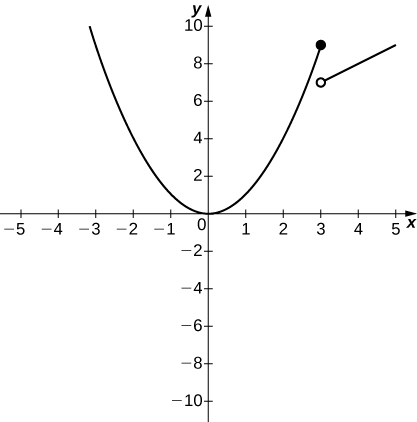
a. 9; b. 7; c. DNE
.
116) g(x)=\begin{cases}x^3−1 & x≤0\\1 & x>0\end{cases}
- a. \displaystyle \lim_{x→0^−}g(x)
- b. \displaystyle \lim_{x→0^+}g(x)
- c. \displaystyle \lim_{x→0}g(x)
117) h(x)=\begin{cases}x^2−2x+1 & x<2\\3−x & x≥2\end{cases}
- a. \displaystyle \lim_{x→2^−}h(x)
- b. \displaystyle \lim_{x→2^+}h(x)
- c. \displaystyle \lim_{x→2}h(x)
- Answer:
- a. 1; b. 1; c. 1
In the following exercises, use the following graphs and the limit laws to evaluate each limit.
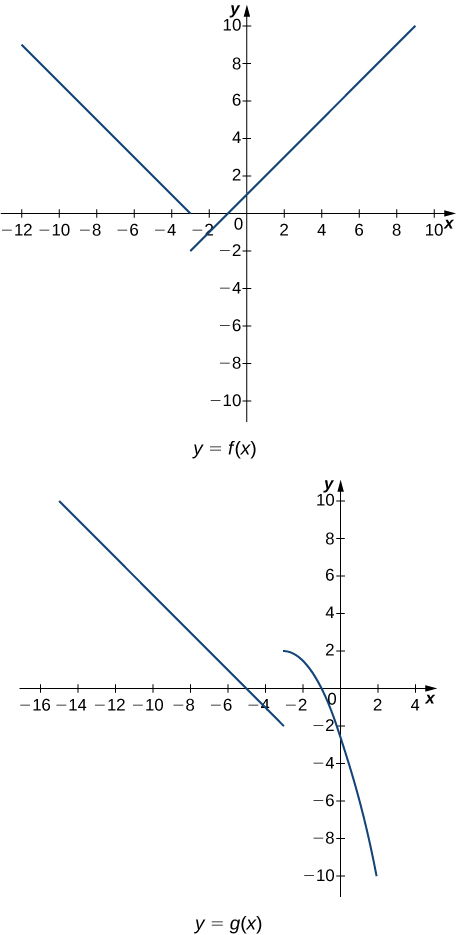
118) \displaystyle \lim_{x→−3^+}(f(x)+g(x))
119) \displaystyle \lim_{x→−3^−}(f(x)−3g(x))
- Answer:
- \displaystyle \lim_{x→−3^−}(f(x)−3g(x))=\displaystyle \lim_{x→−3^−}f(x)−3\displaystyle \lim_{x→−3^−}g(x)=0+6=6
120) \displaystyle \lim_{x→0}\frac{f(x)g(x)}{3}
121) \displaystyle \lim_{x→−5}\frac{2+g(x)}{f(x)}
- Answer:
- \displaystyle \lim_{x→−5}\frac{2+g(x)}{f(x)}=\frac{2+(\displaystyle \lim_{x→−5}g(x))}{\displaystyle \lim_{x→−5}f(x)}=\frac{2+0}{2}=1
122) \displaystyle \lim_{x→1}(f(x))^2
123) \displaystyle \lim_{x→1}\sqrt{f(x)−g(x)}
- Answer:
- \displaystyle \lim_{x→1}\sqrt[3]{f(x)−g(x)}=\sqrt[3]{\displaystyle \lim_{x→1}f(x)−\displaystyle \lim_{x→1}g(x)}=\sqrt[3]{2+5}=\sqrt[3]{7}
124) \displaystyle \lim_{x→−7}(x⋅g(x))
125) \displaystyle \lim_{x→−9}[x⋅f(x)+2⋅g(x)]
- Answer:
- \displaystyle \lim _{x→−9}(xf(x)+2g(x))=( \displaystyle \lim _{x→−9}x)( \displaystyle \lim _{x→−9}f(x))+2 \displaystyle \lim _{x→−9}(g(x))=(−9)(6)+2(4)=−46
For the following problems, evaluate the limit using the squeeze theorem. Use a calculator to graph the functions f(x),g(x), and h(x) when possible.
126) [T] True or False? If 2x−1≤g(x)≤x^2−2x+3, then \displaystyle \lim _{x→2}g(x)=0.
127) [T] \displaystyle \lim _{θ→0}θ^2\cos(\frac{1}{θ})
- Answer:
-
The limit is zero.
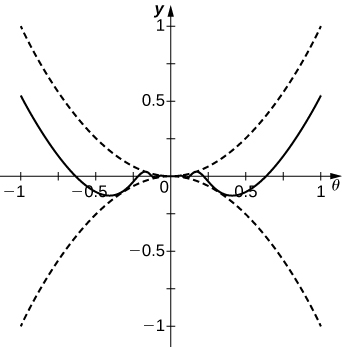
128) \displaystyle \lim _{x→0}f(x), where f(x)=\begin{cases}0 & x rational\\ x^2 & x irrrational\end{cases}
129) [T] In physics, the magnitude of an electric field generated by a point charge at a distance r in vacuum is governed by Coulomb’s law: E(r)=\frac{q}{4πε0_r^2}, where E represents the magnitude of the electric field, q is the charge of the particle, r is the distance between the particle and where the strength of the field is measured, and \frac{1}{4πε_0} is Coulomb’s constant: 8.988×109\,\text{N⋅m}^2/\text{C}^2.
a. Use a graphing calculator to graph E(r) given that the charge of the particle is q=10^{−10}.
b. Evaluate \displaystyle \lim _{r→0^+}E(r). What is the physical meaning of this quantity? Is it physically relevant? Why are you evaluating from the right?
- Answer:
-
a
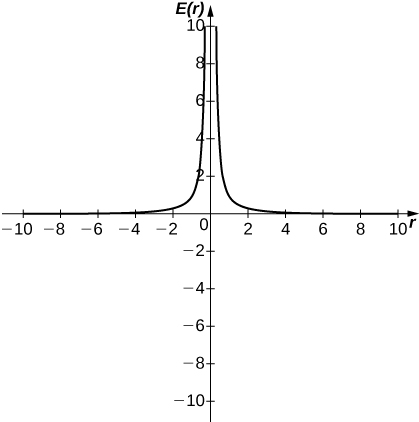
b. ∞. The magnitude of the electric field as you approach the particle q becomes infinite. It does not make physical sense to evaluate negative distance.
130) [T] The density of an object is given by its mass divided by its volume: ρ=m/V.
a. Use a calculator to plot the volume as a function of density (V=m/ρ), assuming you are examining something of mass 8 kg (m=8).
b. Evaluate \displaystyle \lim _{x→0^+}V(\rho) and explain the physical meaning.
Chapter Review Exercises
212) Using the graph, find each limit or explain why the limit does not exist.
a. \displaystyle \lim_{x→−1}f(x)
b. \displaystyle \lim_{x→1}f(x)
c. \displaystyle \lim_{x→0^+}f(x)
d. \displaystyle \lim_{x→2}f(x)
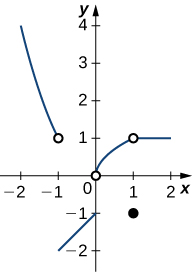
In the following exercises, evaluate the limit algebraically or explain why the limit does not exist.
213) \displaystyle \lim_{x→2}\frac{2x^2−3x−2}{x−2}
- Answer:
- 5
214) \displaystyle \lim_{x→0}3x^2−2x+4
215) \displaystyle \lim_{x→3}\frac{x^3−2x^2−1}{3x−2}
- Answer:
- 8/7
216) \displaystyle \lim_{x→π/2}\frac{cotx}{cosx} This is covered in section 2.4
217) \displaystyle \lim_{x→−5}\frac{x^2+25}{x+5}
- Answer:
- DNE
218) \displaystyle \lim_{x→2}\frac{3x^2−2x−8}{x^2−4}
219) \displaystyle \lim_{x→1}\frac{x^2−1}{x^3−1}
- Answer:
- 2/3
220) \displaystyle \lim_{x→1}\frac{x^2−1}{\sqrt{x}−1}
221) \\displaystyle lim_{x→4}\frac{4−x}{\sqrt{x}−2}
- Answer:
- −4
222) \displaystyle \lim_{x→4}\frac{1}{\sqrt{x}−2}
In the following exercises, use the squeeze theorem to prove the limit.
223) \displaystyle \lim_{x→0}x^2cos(2πx)=0
- Answer:
- Since −1≤cos(2πx)≤1, then −x^2≤x^2cos(2πx)≤x^2. Since lim_{x→0}x^2=0=lim_{x→0}−x^2, it follows that lim_{x→0}x^2cos(2πx)=0.
224) \displaystyle \lim_{x→0}x^3sin(\frac{π}{x})=0

